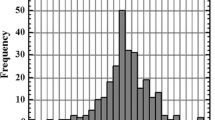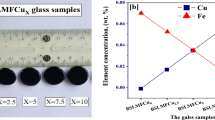Abstract
Intrinsic dosimetry is the method of measuring total absorbed dose received by the walls of a container holding radioactive material. By considering the total absorbed dose received by a container in tandem with the physical characteristics of the radioactive material housed within that container, this method has the potential to provide enhanced pathway information regarding the history of the container and its radioactive contents. We report the latest in a series of experiments designed to validate and demonstrate this newly developed tool. Thermoluminescence (TL) dosimetry was used to measure dose effects on raw stock borosilicate container glass up to 70 days after gamma ray, X-ray, beta particle or ultraviolet irradiations at doses from 0.15 to 20 Gy. Two main peaks were identified in the TL glow curve when irradiated with 60Co, a relatively unstable peak around 120 °C and a more stable peak around 225 °C. Signal strength of both peaks decayed with time. The minimum measurable dose using this technique is 0.15 Gy, which is roughly equivalent to a 24 h irradiation at 1 cm from a 50 ng 60Co source. As a result of fading, this dose would be detectable for approximately 1 year post-irradiation. In a more detailed analysis, the TL glow curves were separated into five peaks centered near 120, 160, 225, 300, and 340 °C. Differences in TL glow curve shape and intensity were observed for the glasses from different geographical origins. These differences can be explained by changes in the intensities of the five peaks. This suggests that mechanisms controlling radiation induced defect formation from gamma, beta, X-ray, and UV sources may be similar.







Similar content being viewed by others
References
Lutze W, Ewing RC (eds) (1988) Radioactive waste forms for the future. Elsevier, New York
Lohmann W, Kesternich W (1982) On the possibility of using amorphous metals in high radiation environments. In: Brager HR, Perrin JS (eds) Effects of radiation on materials: eleventh conference, ASTM STP 782, American Society for Testing and Materials, pp 779–798
MacNeill KR (1991) Recycling waste streams using glass making activities. In: Proceeding of contaminated land: policy, regulation, and technology, London, UK
Moody KJ, Hutcheon ID, Grant PM (2005) Nuclear forensic analysis. Taylor and Francis Group, New York
Mott NF, Davies EA (1979) Electronic processes in non-crystalline materials. Clarendon Press, Oxford
McKeever SWS (1985) Thermoluminescence of solids. Cambridge University Press, Cambridge
Brown G (1975) J Mater Sci 10:1841–1848
Zarzycki J (1991) Glasses and the vitreous state. Cambridge University Press, Cambridge
Kordas G (2005) J Non-Cryst Solids 351:2358–2360
Shkrob IA, Tadjikov BM, Trifanac AD (2000) J Non-Cryst Solids 262:6–34
Shkrob IA, Tarasov VF (2000) J Chem Phys 113:10723–10732
Möncke D, Ehrt D (2004) Opt Mater 25:425–437
Brown G (1975) J Mater Sci 10:1481–1486
Taragin MF, Eisenstein JC (1970) J Non-Cryst Solids 3:311–316
Galimov DG, Yudin DM, Yafaev NR (1973) J Appl Spectrosc 19:1097–1099
Fenstermacher JE (1980) J Non-Cryst Solids 38–39:239–244
Magini M, Sedda AF (1984) J Non-Cryst Solids 65:145–159
Bilan ON, Gorbachev SM, Cherenda NG, Voropai YS, Yudin DM (1991) Radiat Eff Def Solids 115:285–287
Magnien V, Neuville DR, Cormier L, Roux J, Hazemann JL, de Ligny D, Pascarelli S, Vickridge I, Pinet O, Richet P (2008) Geochim Cosmochim Acta 72:2157–2168
Griscom DL (1978) J Non-Cryst Solids 31:241–266
Griscom DL (1971) J Non-Cryst Solids 6:275–282
Horowitz YS (1984) Thermoluminescence and thermoluminescent dosimetry. CRC Press, Boca Raton
Furetta C (2003) Handbook of thermoluminescence. River Edge, New Jersey
Aitken MJ (1985) Thermoluminescence dating. Academic Press, New York
Göksu HY (2003) Radiat Meas 37:617–620
Larsson C, Koslowsky V, Gao H, Khanna S, Estan D (2005) Appl Radiat Isot 63:689–695
Inrig EL, Godfrey-Smith DI, Khanna S (2008) Radiat Meas 43:726–730
Schwantes JM, Miller SD, Piper MK, Amonette JE, Bonde S, Duckworth DC (2009) Radiat Meas 44:405–408
Clark RA, Miller SD, Robertson JD, Gregg RA, Murphy MK, Schwantes JM (2010) Intrinsic dosimetry: a potential new tool for nuclear forensics investigations. In: Proceedings of the 51st annual meeting of Institute of Nuclear Materials Management (INMM), Baltimore
Wertz JE, Bolton JR (1972) Electron spin resonance: elementary theory and practical applications. Chapman and Hall, New York
Knoll GF (1999) Radiation detection and measurement. Hoboken, New Jersey
Srivastava JK, Supe SJ (1983) J Phys D Appl Phys 16:1813–1818
Kitis G, Pagonis V, Carty H, Tatsis E (2002) Radiat Prot Dosim 100:225–228
Chung KS, Park CY, Lee JI, Kim JL (2010) Radiat Meas 45:320–322
Griscom DL (1980) J Non-Cryst Solids 40:211–272
Boizot B, Petite G, Ghaleb D, Calas G (1998) Nucl Instrum Meth Res B 141:580–584
Kumar M, Seshagiri TK, Kadam RM, Godbole SV (2011) Mater Res Bull 46:1359–1365
Mohapatra M, Kadam RM, Mishra RK, Dutta D, Pujari PK, Kaushik CP, Kshirsagar RJ, Tomar BS, Godbole SV (2011) Nucl Instrum Meth Res B 269:2057–2062
Malchukova E, Boizot B (2010) Mater Res Bull 45:1299–1303
Acknowledgments
This research was sponsored by the National Technical Nuclear Forensics Center within the Department of Homeland Security and conducted at the US Department of Energy’s Pacific Northwest National Laboratory, which is operated for DOE by Battelle under Contract DE-AC05-76RL1830. Additional support was received from the Nuclear Forensics Graduate Fellowship Program.
Author information
Authors and Affiliations
Corresponding author
Rights and permissions
About this article
Cite this article
Clark, R.A., Robertson, J.D., Walter, E.D. et al. Intrinsic dosimetry of glass containers: a potential interrogation tool for nuclear forensics and waste management. J Radioanal Nucl Chem 296, 663–668 (2013). https://doi.org/10.1007/s10967-012-2051-0
Received:
Published:
Issue Date:
DOI: https://doi.org/10.1007/s10967-012-2051-0




